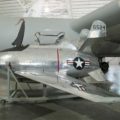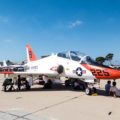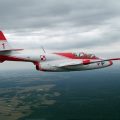
McDonnell FH Phantom |
|
|---|---|
| Kraju | Stany Zjednoczone Ameryki |
| Roli | Samoloty myśliwskie z siedzibą w lotniskowcach |
| Pierwszy lot | 26 January 1945 |
| Zbudowany | 62 |
Tthe McDonnell FH Phantom was a twin-engined jet fighter aircraft designed and first flown during World War II for the United States Navy. The Phantom was the first purely jet-powered aircraft to land on an American aircraft carrier and the first jet deployed by the United States Marine Corps. Although with the end of the war, only 62 FH-1s were built, it helped prove the viability of carrier-based jet fighters. As McDonnell’s first successful fighter, leading to the development of the follow-on F2H Banshee, which was one of the two most important naval jet fighters of the Korean War, it would also establish McDonnell as an important supplier of Navy aircraft. When McDonnell chose to bring the name back with the Mach 2–class McDonnell Douglas F-4 Phantom II, it launched what would become the most versatile and widely used western combat aircraft of the Vietnam War era, adopted by the USAF and the US Navy
Źródła: McDonnell FH Phantom on Wikipedia
| McDonnell Douglas FH-1 Phantom Walk Around | |
|---|---|
| Fotograf | Cees Hendriks |
| Lokalizacja | Niewiedzy |
| Zdjęcia | 24 |
Znajdź zestawy w serwisie eBay:
The McDonnell FH Phantom was a twinjet fighter aircraft designed and first flown during World War II for the United States Navy. It was the first jet-powered aircraft to operate from an American aircraft carrier, and the first jet fighter to serve with both the US Navy and the US Marine Corps. The Phantom was a remarkable technological achievement, demonstrating the feasibility and potential of naval jet aviation.
The Phantom had two Westinghouse turbojet engines mounted in the wing roots, which gave it a sleek and streamlined appearance. The cockpit had a bubble canopy that offered excellent visibility for the pilot. The nose housed four 12.7 mm machine guns, and the wings could carry eight rockets or a drop tank. The Phantom had tricycle landing gear, which raised the tail and prevented the hot exhaust from damaging the carrier deck.
The Phantom made its first flight on January 26, 1945, with only one engine installed. The second engine was added soon after, and the first prototype performed its first carrier landing and takeoff on July 21, 1946, aboard the USS Franklin D. Roosevelt. The Navy ordered 100 production aircraft, but reduced the number to 60 after the end of the war. The first production Phantom flew in October 1946, and entered service in July 1947. The VF-17 squadron was the first to operate the Phantom from a carrier, aboard the USS Saipan in May 1948.
The Phantom was soon surpassed by more advanced jet fighters, such as the McDonnell F2H Banshee and the Grumman F9F Panther. It was retired from active service in 1954, after only seven years of operation. However, it paved the way for future generations of naval jet fighters, and established McDonnell as a leading manufacturer of navy aircraft. The Phantom’s name was revived by McDonnell for its famous F-4 Phantom II, which became one of the most successful and versatile combat aircraft of all time.
Wyświetlenia : 1818









